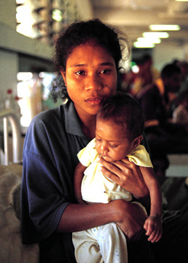 Abeba was pregnant with triplets and arrived at a rural hospital with increasingly painful contractions of early labor. Prenatal care is unknown in this remote part of the globe, but a quick routine blood test was performed. Doctors shared with Abeba some dreadful news: she was HIV positive. Hours later, her babies were born, accompanied by more awful news: they too were HIV positive. Sadly, this hospital lies in a region that offers no treatment for HIV. Without the proper drugs and care, the chance of Abeba or her babies surviving is essentially nil.
Abeba was pregnant with triplets and arrived at a rural hospital with increasingly painful contractions of early labor. Prenatal care is unknown in this remote part of the globe, but a quick routine blood test was performed. Doctors shared with Abeba some dreadful news: she was HIV positive. Hours later, her babies were born, accompanied by more awful news: they too were HIV positive. Sadly, this hospital lies in a region that offers no treatment for HIV. Without the proper drugs and care, the chance of Abeba or her babies surviving is essentially nil.
Accounts like this of Abeba are frightfully common in developing nations. South Africa, for example, suffers from the highest HIV rate in the world. In 2005, there were 5.5 million people – about the population of Missouri – living with HIV/AIDS, and an additional 2 million South Africans with undiagnosed infections (Kaiser Foundation, 2007). Women account for over half (55%) of the HIV infected adults. Tragically, over 290,000 children in South Africa are infected with HIV, and over 1 million children are AIDS orphans (ibid).
Is There Hope? AntiRetroviral Treatment (ART) has dramatically cut the rate of HIV transmission and deaths in wealthier nations. While ART in such nations is relatively expensive and complex, protocols have been developed to successfully provide ART in low-resource countries, where it has also proven successful (Cost-Effectiveness of HIV Treatment in Resource-Poor Settings: NEJM, 2006). However, only about one person in four who needs ART is actually receiving it (WHO, 17 April 2007). This deficiency is largely due to strained resources and lack of health professionals trained to provide low-resource HIV care.
INMED Action Against HIV
INMED is working in cooperation with state-of-the-art institutions to provide training in low-resource HIV care:
• Mseleni Hospital, South Africa
• Banso & Mbingo Hospitals, Cameroon
• Emmanuel Hospitals, India
• Kiwoko Hospital, Uganda
• Macha Mission Hospital, Zambia
• Kijabe Hospital, Kenya
Can HIV be fought on a budget? These institutions are proving that the answer is “Yes.” In the coming weeks, we will be sharing information on opportunities so that everyone – whether health professionals or not – can play a part in fighting HIV where the conditions are most desperate. Certainly people like Abeba and her children will be grateful!
